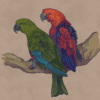
Eclectus

infectus
Size:
As in other Eclectus species, but with smaller wings: 35 cm (13.6 in)
Weight:
As in other Eclectus species: 450-600 g (15.75-21 oz)
Subspecies including nominate:
one
Colour Adult:
Presumed to be similar to Eclectus roratus: Male – all green with red shoulder feathers and some blue primaries. Female – All red with purple belly and chest, with red shoulder feathers (more than male) and darker purple/blue back. Beak black. Feet grey.
Colour Juvenile:
Not recorded.
Call:
Not recorded.
More Information:
Content Sources:
Captive Status:
Not recorded.
Longevity:
—
Housing:
—
Diet:
—
Enrichment:
—
Nest Box Size:
—
Clutch Size:
—
Fledging Age:
—
Hatch Weight:
—
Peak Weight:
—
Weaning Weight:
—
World Population:
None.
IUCN Red List Status:
Extinct
CITES Listing:
Not Listed
Threat Summary:
Described from fossils by D. W. Steadman (2006) from bones found at archaeological (late Holocene) and paleontological (late Pleistocene) sites on three islands in Tonga. Fossils possibly related to a drawing of a parrot from the Malaspina expedition to Vava’u, in C Tonga Archipelago, in 1793. Likely became extinct on Tongapatu during early human settlement 3000 years ago. On Vava’u, it may have survived into historical times. Not recorded thereafter. Likely disappeared due to overhunting and introduced species.
Range:
Tonga Archipelago, Vanuatu and possibly Fiji.
Habitat:
Not recorded.
Wild Diet:
Not recorded.
Ecology and Behaviour:
Not recorded.
Clutch and Egg Size:
Not recorded.
Breeding Season:
Not recorded.

